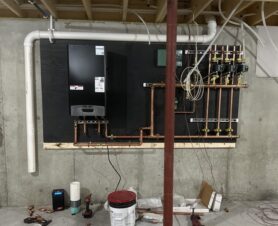Cast Iron Piping Benefits
By Francesca Dunbar
We have to make choices every day. Personal preference seems to dominate over objective reasoning and we get complacent in our decision making. When it comes to drain, waste and vent (DWV) plumbing systems there is an ongoing debate over which is a better solution, iron or plastic. Both products have their advantages and disadvantages. Designers and contractors are experiencing tremendous pressure to value engineer projects. Most builders are not willing to give up features in their design to bring the project costs down and look to cut corners on building materials to help reduce the overall project cost. These value engineered tradeoffs are typically not seen until a building is occupied.
Life Safety – Making the Right Choice
The superiority of cast iron (CI) over polyvinyl chloride (PVC) piping in fire safety cannot be overstated. Many people who die in fires do not perish from flame or heat, but rather from the gases released during the heating and combustion of typical building materials or furnishings. Slowing or stopping the spread of these gases through aggressive firestopping is a proven life saver. Contractor and building owners today are concerned about liability.
Most experts agree that CI provides unsurpassed fire resistance. Cast iron does not burn, does not off-gas when heated to temperatures normally encountered in structure fires, it is easy to install, and has superior durability often out lasting the life of a building. This resistance to burning has the added benefit of requiring simple, low-cost firestopping between the annular space between the pipe and wall penetration. That is not the case with PVC piping where the initial cost savings are frequently offset by the added perfunctory material costs. Cast iron pipe and fittings are joined together with no-hub couplings consisting of neoprene gaskets and stainless steel shields and bands. These can be assembled or disassembled very easily.
Something else to consider if choosing PVC as it relates to fire wall penetrations. PVC is combustible and requires complex firestopping systems – each penetration between the pipe and wall infiltration must be sealed with an intumescent material. In the case of fire due to heat, PVC piping will melt away. Therefore, firestopping with intumescent product is needed to fill each and every void and penetration. This intumescent firestopping system is significantly more expensive than the simple and low-cost measures required for cast iron.
Sound Attenuation
Cast iron is often referred to as the “quiet pipetm” because of its superior noise suppression unlike PVC piping. Studies have shown CI to be a superior product in controlling noise due to its density. This makes cast iron ideal for condominiums, hotels, healthcare facilities and educational institutions. Unlike PVC, cast iron soil pipe effectively suppresses the sound of swooshing water cascading down from upstairs fixtures. This sound attenuation feature can be a major benefit in quality residential and commercial construction, where building owners and tenants understand the advantage of iron by the very first flush.
On the other hand, PVC used in drain and waste systems is noisy and annoying and often the cause of tenant frustration. If you’ve ever stayed in a hotel plumbed with PVC, you can often hear others showering and flushing toilets depriving guests from the well needed rest they desire. While plastic piping is an inexpensive material, it may not be the right product for every application. The problem with PVC pipe in drain and waste systems is that it produces a lot of noise due to the innate properties of low density plastic and the cementing of pipe and fittings together. To combat the noisy PVC piping system one solution is to wrap the PVC pipes with a good insulating material such as fiberglass or neoprene foam jacketing. The intrinsic properties of cast iron pipe along with the separation of the pipe and fittings by the use of a gasket or coupling is highly effective in reducing the likelihood of sound traveling through the system. Don’t get me wrong, there are special applications for PVC piping, but not in drain and waste applications.
Noise Level Chart
A noise level chart showing examples of sounds with dB levels ranging from 0 to 100 decibels.
|
0 = Healthy hearing threshold |
|
30 = A voice whisper |
|
25 = Cast iron vertical enclosed pipes (average) |
|
33 = PVC vertical enclosed pipes (average) |
|
50 = Light traffic or sound of a refrigerator |
|
70 = A shower or dishwasher running |
|
75 = A toilet flushing or vacuum cleaner |
|
100 = Riding a motorcycle or operating a hand held drill |
Summary of overall noise levels in dBA emitted by cast iron and PVC pipes while evacuating a 1.6 gallon water flush test. Significant findings that cast iron pipes are quieter than PVC whether or not the pipes are enclosed. This information is based on an independent research study by MJM Acoustical Consultants, Inc.
Listen Up – Noise Pollution is a Problem
Commercial building designers and engineers need to take note of the acoustical performance of the building project and be very cautious of the potentially negative effects of value engineering. Excessive noise from plumbing systems is typically unnoticed until the building is occupied, creating ongoing problems for the occupants. Sound attenuation is regularly value engineered out of jobs, often the result of product substitutions and misguided cost cutting measures. Beware of the unexpected consequences of value engineering.
The World Health Organization (WHO) has done extensive studies in healthcare facilities and has identified noise levels around rooms at night as disruptive to patients. This is especially true in hospitals with multiple levels. These types of structures also have additional noise pollution from waste water evacuation from toilets flushing, showers and storm drains. Excessive noise can lead to sleep disruption and increased levels of stress thus hindering the healing process sought in a hospital setting.
Studies have also concluded classroom noise interferes with the ability for a teacher to educate students effectively, and students to learn. Raising the voice level provides little compensation. ANSI Standard S 12.60-2002 Design Requirements and Guidelines for Schools recommend a maximum of 35 decibels for background noise. There is a direct link between the classroom acoustic environment and the scholastic achievement of students. The result of a US Government Accounting Office survey found that 28% of the nation’s schools reported “acoustics for noise control” as their top environmental problem. This suggests that the 28% figure from this survey may be a substantial understatement of the problem of acoustic barriers in schools since a background noise level of 50 db is 15 dB above the recommended limit included in a US standard for classroom acoustics.
The attributes of cast iron when it comes to sound attenuation cannot be overlooked. Due to its sound-deadening properties, cast iron inherently has a dense molecular structure and a natural heavy mass making it the quieter solution. According to a study by Polysonics Acoustical Engineers, cast iron is 750% more effective in silencing plumbing noise when compared to PVC. With CI, sound is effectively muffled rather than transmitted, as it is with PVC pipe. Noisy PVC piping can be masked by utilizing sound-deadening insulation that is carefully installed with neoprene foam jacketing or other insulation processes but there are again added costs to even come close to the quiet CI piping.
Friend, Foe or Both?
In conclusion, so do you know which product is better, cast iron or plastic? Both products have their advantages and disadvantages, though cast iron is more environmentally friendly than plastic as it is made from ~100% post-consumer scrap iron while on the other hand, thermoplastic piping is produced using petroleum derived materials. So we go back to which product is better. Well, the answer may be to consider using both together. Plastic pipe is a great choice for the vent system since air doesn’t create vibrations and will be whisper quiet. While on the other hand using cast iron is an ideal solution for underground piping and vertical stacking of indoor pipes. This amalgamated method will benefit the occupants seeking a quiet and durable plumbing system that is a cost effective solution.
Word to the wise, consider the added costs if you choose PVC as it will require more hangers, screws, fasteners, primer, glue, additional labor costs, inspections, neoprene foam jackets to deaden sound, or insulation to muffle the noisy pipes. These supplementary costs are often overlooked when value engineering a project and can cost just as much if not more than a cast iron DWV system.
About the Author:
Francesca Dunbar is the Director of Marketing for the McWane Plumbing Group Division. She can be reached by email at Francesca.Dunbar@McWanePlbGrp.com.
Quiet Pipe is a trademark of Cast Iron Soil Pipe Institute “CISPI”.
REFERENCES
1. The Impact of Classroom Acoustics on Scholastic Achievement by Louis C. Sutherland and David Lubman, 17th Meeting of the International Commission for Acoustics, Rome, Italy, Sept. 2-7, 2001
2. Plumbing Engineer – Features: June 2012: Sound design in drain, waste and vent lines http://www.plumbingengineer.com/june_12/piping_feature.php
3. Acoustic Control LLC http://www.acousticontrol.com/hospital-acoustics.html





Join the conversation: